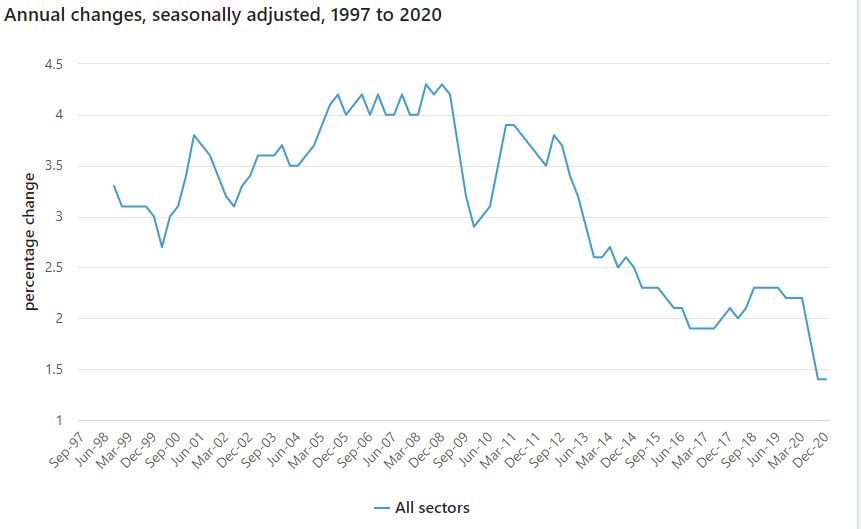The moderate growth recorded by the Australian Bureau of Statistics (ABS) was ahead of the 0.3% rise pencilled in by economists.
Wage growth continues to outpace inflation which sits at 0.9% annually according to December data from the ABS.
Michelle Marquardt, Head of Prices Statistics at the ABS, said work conditions returning to pre-COVID normality, as well as regulatory factors, had assisted growth.
"December quarter’s moderate growth was influenced by businesses rolling back short-term wage reductions, returning wages to pre-COVID levels," Ms Marquardt said.
"The phased implementation of the Fair Work Commission annual wage review also had a small positive impact on wages."
She added the public sector was still suffering from COVID-related factors, with the wage growth in the private sector almost doubling public's.
“In original terms, wages rose 0.5% in December quarter 2020. Private sector wages rose 0.5%, outpacing the public sector rise of 0.3%.
"Wage freezes have had an impact on the public sector which recorded its lowest annual increase (1.6%) since the commencement of the series.”
Private sector growth was fueled by the continued restoration of hourly wages back to pre-pandemic levels, following reductions in the previous quarters.
IFM chief economist, Alex Joiner, noted on Twitter the rebound in wage growth may cause the Reserve Bank (RBA) to have to rethink policy.
Wages data rebounds in Q4 after recent weakness, will add to the belief that the #RBA will need to wind back policy sooner than it has outlined but it may just be a one off #ausbiz pic.twitter.com/rusyWmvGfW
— Alex Joiner (@IFM_Economist) February 24, 2021
Westpac economist Lochlan Halloway echoed Mr Joiner's sentiments, stating concerns about how the RBA would achieve its goals.
"The RBA has stated that it will not raise the cash rate until consumer price inflation is sustainably within the 2 to 3% target," Mr Holloway said.
"To achieve this, the bank believes that annual wages growth will need to be running at around 3½ to 4%. Such a pace has not been seen since the post-GFC mining boom in 2012.
"Although the labour market has posted a significant recovery since the nadir of the crisis, the unemployment rate (6.4% in January) is still roughly 1.3% above pre-COVID levels.
"Full employment, which the RBA estimates to be in the order of 4.5%, is still a way off - along with any consequent lift in wages growth."
The professional, scientific and techinical services industry saw the biggest rise in wage growth, up 1.2%, after significant wage reductions saw it fall 0.5% in June.
Annual wage growth to the December quarter 2020 ranged from 0.3% for the accommodation and food services industry to 2.4% for the education and training industry.
Victoria recorded the highest quarterly rise at 0.7%, after wage reductions contributed to a 0.1% fall in June and minimal wage growth in September (0.2 per cent).
The Northern Territory also recorded a quarterly rise of 0.7% based mainly on regular public sector wage growth.
South Australia and the Australian Capital Territory recorded the lowest quarterly wage index rise of 0.2%.
Photo by Mario Gogh on Unsplash




 Denise Raward
Denise Raward
 Harry O'Sullivan
Harry O'Sullivan

 William Jolly
William Jolly


